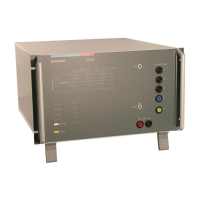EM TEST CNI 501 / CNI 503
Manual of operation V 3.32 13 / 41
DC current capability of CNI 503Nx
CNI models with a built in ac mains contactor have a reduced dc switching capability. This current rate depends
on the following parameters:
- contactor model
- applied dc voltage
- time constant L/R of the dc circuit
The following list shows the dc current of the most models.
- Internal decoupling inductance 2 x 1.5 mH (16A models)
CNI 503Nx with rated power 3x480V 16A
24V DC : 25A
48V DC : 10A
60V DC : 8A
110V DC : 2A
CNI 503Nx with rated power 3x480V 32A
24V DC : 40A
48V DC : 23A
60V DC : 18A
110V DC : 8A
220V DC : 1A
24V DC : 19A
48V DC : 10A
60V DC : 5A
110V DC : 1.8A
220V DC : 0.3A
CNI 503Nx with rated power 3x480V 63A / 100A
24V DC : 70A
48V DC : 60A
75V DC : 60A
110V DC : 8A
220V DC : 6A
24V DC : 40A
48V DC : 30A
75V DC : 30A
110V DC : 3A
220V DC : 1A
CNI 503Nx with rated power 3x690V 63A / 100A
< 75V DC : 220A
110V DC : 110A
< 75V DC : 160A
110V DC : 80A
The IEC 60947-4-1 rating system is broken down into different utilization categories that define the value of the
current that the contactor must make, maintain, and break.
Non inductive or slightly inductive loads, resistance furnaces, heaters
Shunt motors, starting and breaking of a shunt motor during inching or plugging. The time constant
shall be less than or equal to 2 msec. On de-energization, the contactor will break around 2.5 times the
starting current at a voltage that may be higher than the line voltage.
Series-motors, starting and breaking of a series motor during inching or plugging. The time constant
being less than or equal to 7.5 msec. On energization, the contactor sees about 2.5 times the nominal
full load current. On de-energization, the contactor breaks the same amount of current at a voltage
which can be equal to the line voltage.

